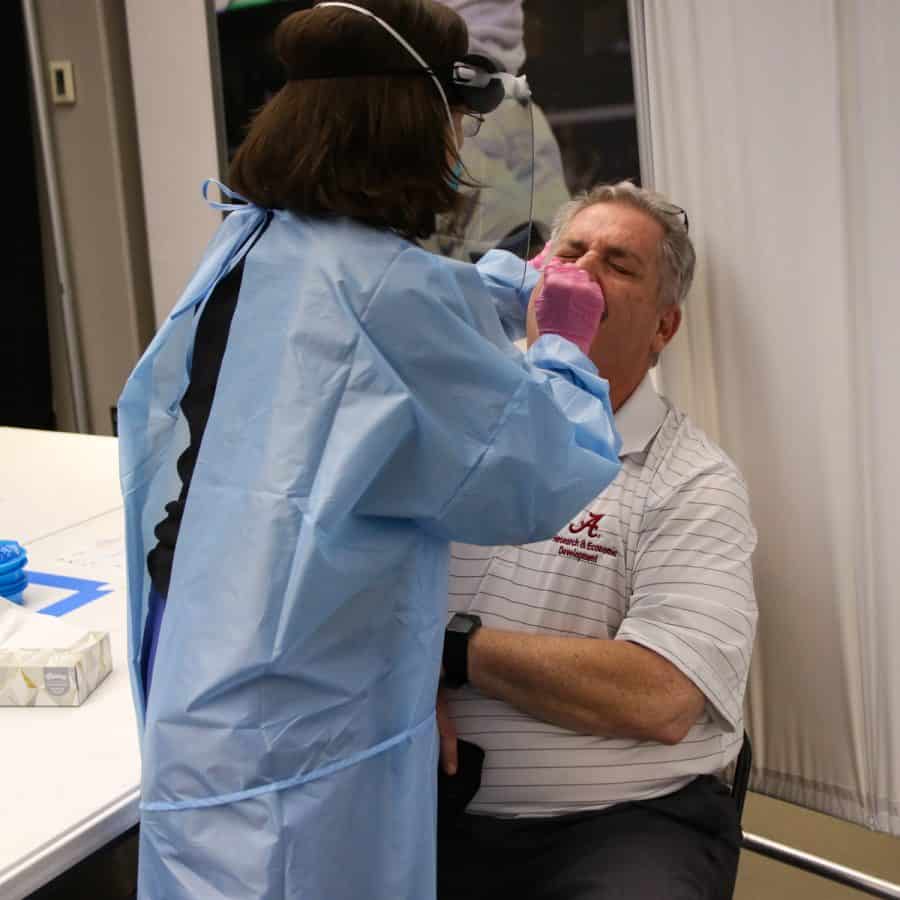Coronavirus data still opaque as fall semester begins
August 20, 2020
While some schools have gone completely remote, the University has settled on a hybrid learning plan, with the ability to go remote at any point. Following the release of the UA Return Plan, students, faculty and staff did not expect the June initiative to be the last of major announcements as they prepare for the fall semester. Instead, one professor said, things have only gotten more unclear.
BY THE NUMBERS
On August 13, a word from Rona Donahoe, UA Faculty Senate president, circulated in the “West Alabama COVID-19 Information” Facebook group. It was reported in the group that UA Provost James Dalton was aware of faculty, staff and student test results, and he shared them exclusively with the Steering Committee.
“Faculty and Staff testing indicated that 1.4% were positive (but asymptomatic) for COVID-19,” Donahoe said. “At least one of these positive tests was a false positive. For the 5,600 student tests performed up to that point, 5% had tested positive (but were asymptomatic).”
In a Faculty Senate meeting held the day prior to the start of the semester, UA President Stuart Bell explained the discrepancy between the 5% positivity rate shown by the first 5,600 student tests and the 0.94% positivity rate for students shown now.
The data that contributed to the 5% positivity rate included positive results students received between two and three months prior, Bell said. Once these 180-200 outdated positive results were moved to another data group, the current positivity rate dropped. The University is urging those who have had COVID-19 prior to returning to campus to not retest and instead fill out a different form.
Dalton was unable to provide an answer as to what percentage of positive testing among campus-goers would result in a shutdown of the University but suggested the value may be determined at some point.
GATEKEEPING
Shane Dorrill of UA Strategic Communications did not believe that there would be a “single ‘threshold positive test rate number’ that would dictate an operational decision, either from return testing, sentinel, or symptomatic” reports. Instead, “many data points will be reviewed” to make any final decisions on UA operations.
“I will recommend to the UA Administration that COVID testing data (number of tests performed and % testing positive) be posted and updated weekly to a centralized location that can be accessed by employees and students,” Donahoe said. “It is essential that members of the campus community should stay informed and be aware of any trends.”
At Tuesday’s Faculty Senate meeting, Donahoe posed this concern to Bell who expressed interest in prioritizing this request on their agenda.
Dorrill told the Crimson White that the process of return testing is “ongoing” and said that “data would not be released until it is more complete.”
This gatekeeping of information is making some community and campus members assume the worst.
“The University of North Alabama and Troy University both publish the testing data they collect,” said Garrett Bridger Gilmore, a member of Safe Return UA. “I want to know why we don’t publish our numbers, because I think most people who work at UA and who live in Tuscaloosa would feel more confident if they had all the information that the university has.”
Even if it is not the numbers or news anyone wants to hear, Gilmore said he believes it is better than nothing.
“Students, staff, faculty, residents — we’re all adults,” Gilmore said. “It’s insulting for UA to act like this data they collect is not fit for public consumption. If they don’t want to publish their numbers, the only logical interpretation is that the numbers are bad.”
Meredith Cummings, an instructor in the Journalism and Creative Media department, initially decided to leave campus on March 10. This was days before the school went officially online, but Cummings believed it was in her best interest to stay home because she had Type 1 Diabetes, classifying her as “high risk.” This semester, Cummings will be teaching remotely.
“There was never going to be a plan that I felt comfortable with if it involved being indoors and within six feet of someone,” Cummings said. “So, no, I had never even considered going back.”
While Cummings felt her department was accommodating to her situation, she said administrators could do more.
“My experience has been wonderful; however UA overall, I would like to see them reporting numbers daily or whatever is reasonable,” Cummings said. “You know, every couple of days, I feel like we do need those numbers. And ‘we’ as in the public, not just UA faculty and staff. I think everyone needs those numbers.”
LACK OF ENFORCEMENT
Some of the most critical parts of the University’s plan rely heavily on student initiative and responsibility through contact tracing and symptom tracking.
Gilmore also voiced concern for potential student punishment outlined in the Return Plan which might result in students being more aggressively policed.
Potential punishments include anything from a letter of reprimand and additional training for the first violation to a disciplinary probation and conduct charge for the third. If a student organization is found guilty, after four violations, they could face removal from campus for one academic year.
Some student organizations, such as those that are Greek-affiliated, are characterized by social activities. With large parties, intermixing of communities and tight living quarters all a part of their usual operations, Gilmore fears that the power of Greek life may win over anyone trying to enforce the rules.
Crimson White photographer Hannah Saad covered last weekend’s Bid Day activities, UA affiliated and not, which stunned Tuscaloosa Mayor Walt Maddox.
“Will the administration really hold the Greek system accountable?” Gilmore said. “That’s the big question on many faculty members’ minds, and I wouldn’t say that most faculty are optimistic about that.”
On August 13, Maddox announced in a Pre-Council Agenda Briefing that, in compliance with the Alabama Department of Public Health (ADPH)’s reporting policy, students who test positive will have their case “count” towards their home county or state’s numbers, not Tuscaloosa’s. This quickly worried community members, who wished to know if campus infections could be right in front of their eyes with no notice.
Later, ADPH came out to correct Maddox’s belief in a tweet, specifying that the case would be assigned to a positive-tester’s “place of usual residence in the academic year,” which may as well be Tuscaloosa.
During the Faculty Senate meeting held the day before classes started, Bell said, to his knowledge, students who test positive before returning to campus will contribute to the case count of their home residence. Students who test positive after returning to campus will be included in Tuscaloosa’s case count.
These questions continue to circulate within a week of the start of classes. While the science evolves and new information becomes publicized, Gilmore hopes that UA’s data does as well.
“I feel like things are what they are at this point,” Gilmore said. “It seems like we are hearing every day that COVID-19 is transmitted through air more efficiently than we thought a month ago and that young people are able to transmit it more than we initially thought.”
Follow The Crimson White for the latest updates.





















